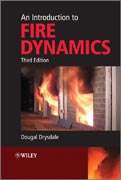
A new edition of the leading introduction to the science of fire phenomena, complete with the latest research, data and additional problems This book is unique in that it identifies fire science and fire dynamics and provides the scientific background necessary to the development of fire safety engineering as a professional discipline. It is essential reading for all involved in the field from fire safety engineering students to fire prevention officers. After 21years as a bestseller, Dougal Drysdale's classic introduction has been brought up-to-date with the latest data and research in a third edition. Features numerical problems with answers illustrating the quantitative applications of the concepts presented. Includes quantitative experimental data regarding material properties. Successfully course-tested at Massachusetts' Worcester Polytechnic Institute and the University of Edinburgh, and widely adopted throughout the world. Of relevance to those working in building design, fire physics and chemistry. INDICE: About the Author Preface to the Second Edition Preface to the Third Edition List of Symbols and Abbreviations 1 Fire science and combustion 1.1 Fuels and the Combustion Process 1.2 The Physical Chemistry of Combustion in Fires Problems 2 Heat transfer 2.1 Summary of the heat transfer equations 2.2 Conduction 2.3 Convection 2.4 Radiation Problems 3 Limits of flammability and premixed flames 3.1 Limits of flammability 3.2 The structure of a premixed flame 3.3 Heat losses from premixed flames 3.4 Measurement of burning velocities3.5 Variation of burning velocity with experimental parameters 3.6 The effect ofturbulenceProblems 4 Diffusion flames and fire plumes 4.1 Laminar jet flames 4.2 Turbulent jet flames 4.3 Flames from natural fires 4.4 Some practical applications Problems 5 Steady burning of liquids and solids 5.1 Burning of liquids 5.2 Burning of solids Problems 6 Ignition: The initiation of flaming combustion 6.1 Ignition of flammable vapour/air mixtures 6.2 Ignition of liquids 6.3 Pilot ignition of solids 6.4 Spontaneous ignition of combustible solids 6.5 Surface ignition by flame impingement 6.6 Extinction of flame Problems 7 Spread of flame 7.1 Flame spread over liquids 7.2 Flame spread over solids 7.3 Flame spread modelling 7.4 Spread of flame through open fuel beds 7.5 Applications Problems 8 Spontaneous ignition within solids and smouldering combustion 8.1 Spontaneous ignition in bulk solids 8.2 Smouldering combustion 8.3 Glowing Combustion Problems 9 The pre-flashover compartment fire 9.1 The growth period and the definition of flashover 9.2 Growth to flashover Problems 10 The post-flashover compartment fire 10.1 Regimes of burning 10.2 Fully-developed fire behaviour 10.3 Temperatures achieved in fully-developed fires 10.4 Fire resistance and fire severity 10.5 Methods of calculating fire resistance 10.6 Projection of flames from burning compartments 10.7 Spread of fire from a compartment Problems 11 Smoke: Its Formation, Composition and Movement 11.1 Formation and measurement of smoke 11.2 Smoke movement 11.3 Smoke control systems References Answers to Problems Author Index Subject Index
- ISBN: 978-0-470-31903-1
- Editorial: John Wiley & Sons
- Encuadernacion: Rústica
- Páginas: 584
- Fecha Publicación: 26/08/2011
- Nº Volúmenes: 1
- Idioma: Inglés
